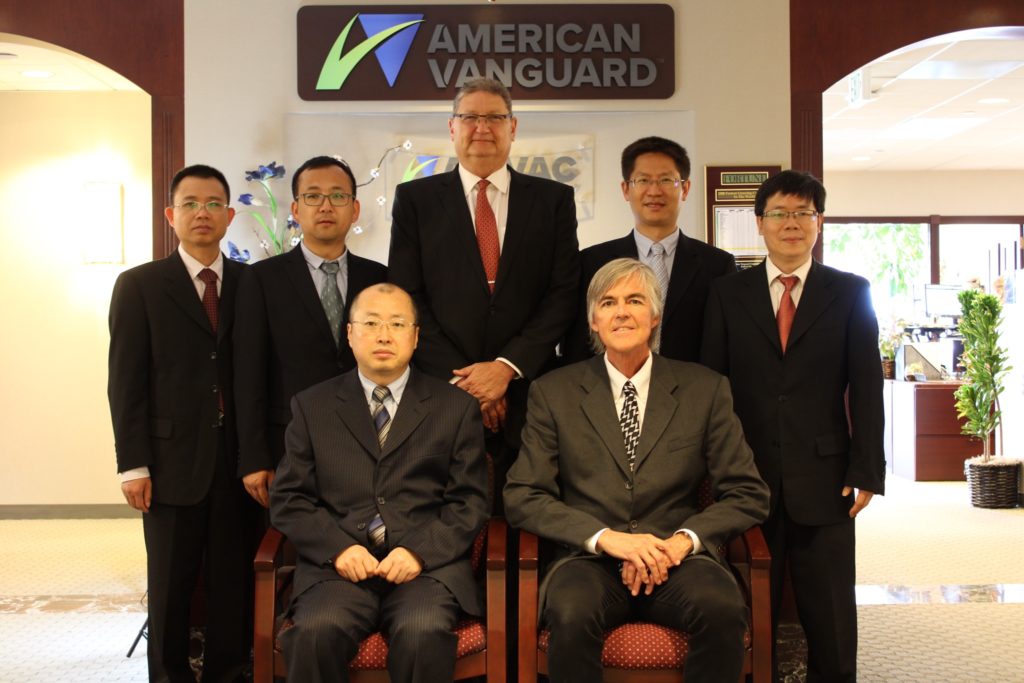AMVAC COO: Modern Agriculture Enters Technology Stage

Trogele (center), with CEO Eric Wintemute (bottom right), and Chinese Ministry of Agriculture officials at AMVAC’s Southern California headquarters.
By Dr. Bob Trogele
As a child I was raised on a traditional family farm. Little machinery, compost for plant nutrition, manual weeding, manual irrigation. Consumers would likely consider this organic farming today. In those days, fungus and insect damage were the norm. Often you would find an apple with a worm, a cherry with a scab or a snail on the back of a leaf, and you would just cut out the spoiled piece.
Over the course of the last half century, traditional agriculture gave way to modern agriculture, as scientific and technology solutions began to appear. Harvesters replaced manual labor. Herbicides saved backstabbing labor. Yields improved to meet global food demand. Family farms became businesses, and domestic businesses went international.
Last week, I had the pleasure of hosting Zhang Xingwang, Director General of the Department of Farm Mechanization, Ministry of Agriculture and Rural Affairs) of the People’s Republic of China and his division director management in our corporate headquarters in Newport Beach, California. I spoke to them about the new era of global agriculture that is now supplanting modern ag. This is the substance of those discussions.
Farming is getting more complex for both modern agriculture growers as well as for organic farmers. We are seeing a clear divide between large and small farms across the globe, with larger operations in places like the Americas, Eastern Europe, Australia, and the United Kingdom and smaller farms in India, China, Southeast Asia, and Africa. Regardless of the size of the farm, however, the same issues tend to face growers globally. Production quality, quantity, consistency, and cost are all keys to survive in a competitive global economy. Further, farmers must keep an eye on numerous other considerations while protecting what are typically razor thin margins. These considerations include consumer preferences, changing nutrition trends, safety concerns, contract marketing, labor access, balance sheet management, financing, and technology changes/adoption, to name but a few.
The complexity and dynamic nature of the global agriculture market carries over into industries that serve that market. Companies in the crop input business (seeds, fertilizer, crop protection, biostimulants, and the like) must be prepared to respond to rapid change, recognize new trends, and take advantage of opportunities that will accompany the continued transformation of global ag.
The M&A trend intensifies
Globalization will continue as many regional, mid-sized companies (~$500M in revenue) seek international growth and expansion. This is occurring through joint ventures, acquisitions, alliances, and mergers. Business streamlining by larger multinationals will continue as they focus on core business strategies and profitability – likely resulting in divestments of non-core business units and mature/generic products. Regional or local entrepreneurial enterprises are looking to divest as they face succession issues or working capital risk to expand into more competitive segments. Generic competition is forcing businesses to adapt rapidly as segments become more commoditized and larger growers gain purchasing scale.
The value shift continues to be dynamic
Through globalization, increased funding for research and development will tend to open up new adjacent spaces such as biostimulants or precision agriculture technology. Further, the emergence of China and India within the crop input segment will likely result in the shifting resources for technology investments to Asia. Look for both countries to provide more technology in the future. Within the agchem segment, Sinochem alone controls one of four dollars in global revenues. Thus, we can expect that competition for energy, food, and water resources will become more strategic and political. The only counter-trend in this dynamic evolution is the de-globalization caused by continuing political and social unrest (i.e. terrorism, trade tariffs/wars, protests, and activism). This will require focused investments into politically stable economic environments.
Where does this lead?
New business approaches (e.g., marketing via the Internet, start-ups in robotics, sensor technology, etc.) are evolving and being tested, but will require different human resource skills, equity investment, and participation (i.e., private equity). These will likely be disruptive to modern agriculture as we know it today. Global competition will increase as the degree of internationalization – regional expansion by Northeast Asia technology and manufacturing companies – intensifies commoditization and new business approaches restructure the value chain. Customer international expansion and backward integration to manufacturing will further drive competition and potentially new business approaches (i.e. e-business) across borders. As Charles Darwin once stated, “Not the strongest species survive but those who adapt.” Suppliers, the channel, and growers will need to adapt.
Opportunities are on the horizon
Current trends of demand for greener solutions, solving pest resistance issues, dealing with grower consolidation at retail, financing increasing regulation costs, solutions to improve soil health and precision technology breakthroughs – especially as artificial intelligence algorithms get introduced – present areas to excel operationally and to innovate. Society is demanding better use of water, sustainable soil health, a safe supply of high quality nutrition, and all with less environmental impact. New technologies are emerging: digital biology, affordable genomics, block chain, automation, robotics, sensor technology, artificial intelligence. Mastering these opportunities and fully integrating technology into farming will bring the about the “Ag Technology Era” sooner than later.
Editor’s Note: Trogele is Chief Operating Officer of AMVAC.






